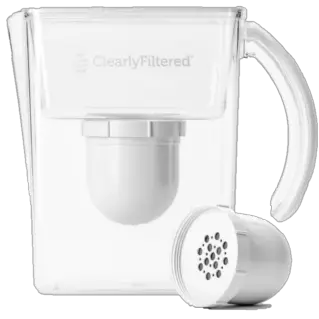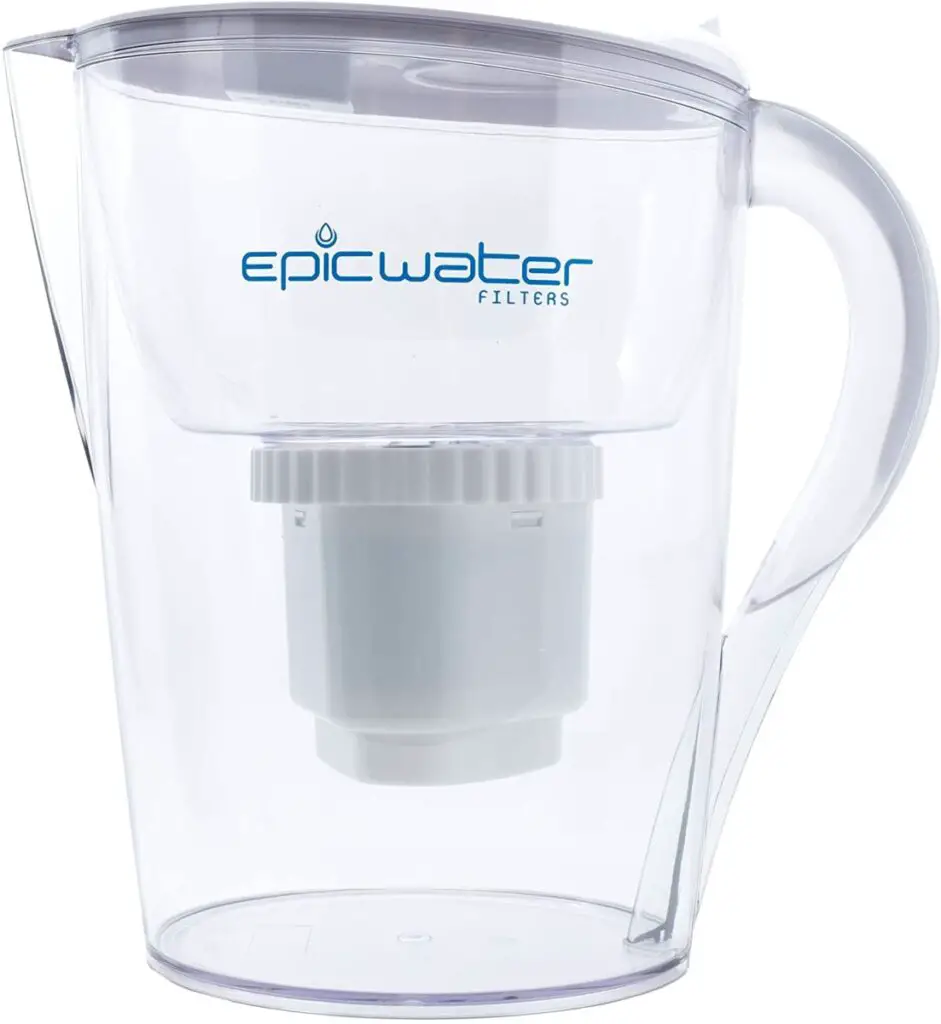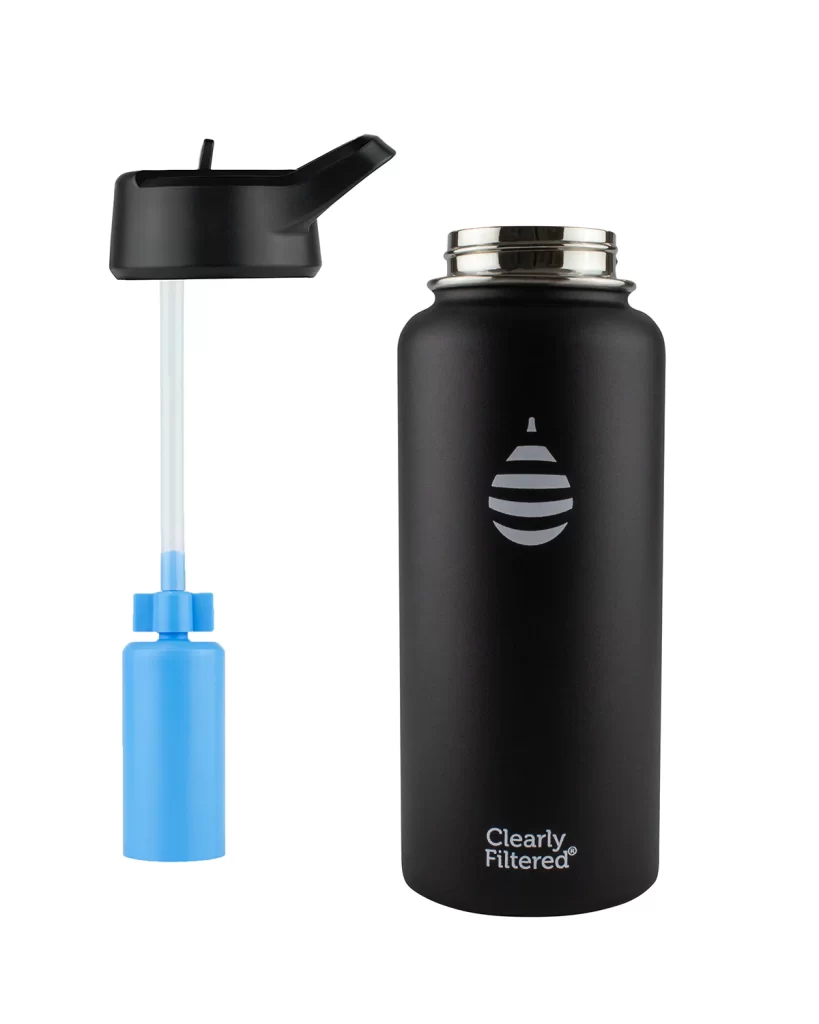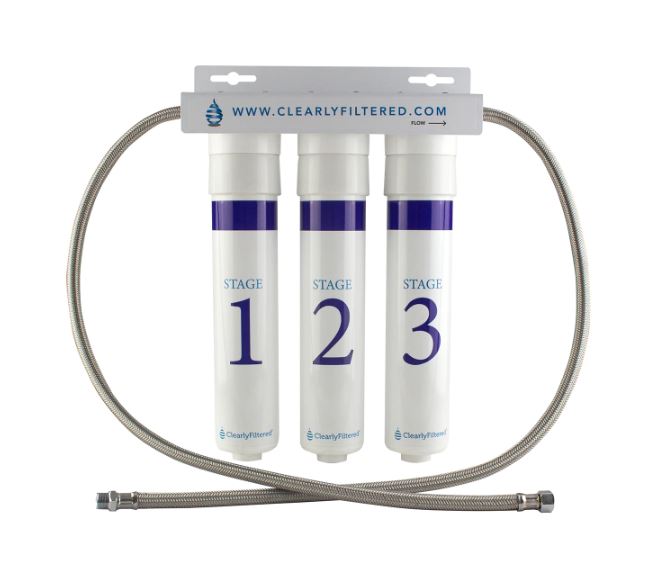Atrazine is a common chemical used on farms to kill weeds. It’s made in laboratories and not found in nature. But because of how common it is, atrazine can find its way into your drinking water supply and you should ideally use water filters to remove it.
Atrazine can be removed from water using activated carbon. Reverse osmosis systems, water filter pitchers, bottles and under-sink filters that use powdered activated carbon can remove more than 90% of atrazine in water. Those that use granular activated carbon can only remove around 35%.
In this article, we look at what atrazine is and how it enters our water. But more importantly, we look at the different types of water filters that can remove atrazine from water.
- Atrazine is a herbicide used on crops like corn, maize, and sugarcane, and has been linked with negative effects on fertility and potential birth defects.
- Water filters that use powdered activated carbon can remove more than 90% of atrazine in water.
- Distillers can efficiently reduce the amount of atrazine in your water.
How Water Filters Remove Atrazine
Atrazine is extensively used by farmers all over the country to control weeds in their fields. Over the years, it has become a common drinking water contaminant. Because of its potential toxic effects on the body, the maximum amount of atrazine considered safe in drinking water is just 0.003mg/L – an incredibly low number.
Fortunately, atrazine and other herbicides can effectively be removed from your drinking water by home water filters. The most common method of removing atrazine from water is activated carbon filtration, which is used in a large range of filter types, including filter pitchers.
Activated Carbon
Activated carbon filters are made from organic materials such as coconut shells or charcoal. They’re also known as charcoal filters.
An activated carbon filter has a very large surface area which allows it to trap particles, like atrazine through a process called adsorption. In fact, activated carbon filtration is so efficient it’s been around for centuries.
Activated carbon removes atrazine very efficiently, but there is a difference between powdered and granular activated carbon.
- Powdered activated carbon can remove more than 90% of atrazine in water, but granular can only remove around 30%.
So, if you’re looking for a filter for atrazine, make sure it uses powdered activated carbon – we’ve got you covered with a breakdown of the different types and brands that do, so keep reading.
Distillation
Another purification method that you can use to remove atrazine from drinking water is distillation.
In this process, water is boiled until it becomes steam, leaving the atrazine behind. The steam is then collected in a different storage compartment and condenses back into liquid form. The downside of the distillation method is that the water tends to taste “flat”. The good nutrients in the water are also removed from it. Water distillation can also be very costly and relatively slow.
So, activated carbon filtration is currently the best method of choice for removing atrazine from drinking water.
Most water filters, like pitchers, under-sink and reverse osmosis include activated carbon in their filtration systems. It might be as a pre-filter or post-filter. Often, it’s in the form of Granular Activated Carbon (GAC), which doesn’t remove a lot of atrazine, so remember to look for powdered activated carbon if you can.
Types of filters that remove atrazine
There are a few different types of filters that you can choose from to remove atrazine from your water.
1. Water Filter Pitchers
Water filter pitchers can remove as much as 99% of the atrazine from your drinking water if they have a powdered activated carbon filter.
In general, most water filter pitchers also remove several other contaminants from water. Your choice of water filter pitcher depends on what other requirements you have, like what other type of contaminants you want to remove, such as PFAS.

We recommend the Clearly Filtered Water Pitcher over any other. It can remove more than 99.8% of the atrazine in your water.
Another great option is the Epic Pure Water Filter Pitcher as it removes 99.8% of atrazine.
It comes with a powerful filter that also removes other herbicides, including more than 99.9% of glyphosate.

Water Purification Guide has more information on which water filters remove glyphosate (“round-up”) available here.
Whereas Brita, PUR, Nakii, and Soma use granular activated carbon, which can’t effectively remove atrazine.
2. Water Filter Bottles
The filters that water bottles use are small and can’t filter out nearly as many contaminants as bigger filter systems, such as under-sink filtration systems.
In fact, most water filter bottles will only remove chlorine and bad odors.
However, there are a couple of water bottle filters that can remove or reduce the amount atrazine in your drinking water, like this one:

Clearly Filtered’s Insulated Stainless Steel Filtered water bottle can remove 99.9% of atrazine from your drinking water.
3. Reverse Osmosis
Reverse osmosis is a water purification method that pushes water under pressure through a semi-permeable membrane, also known as the reverse osmosis membrane. As water passes through the tiny holes in the membrane, contaminants are held back. As a result, the water that emerges is relatively contaminant-free.
Reverse osmosis can remove atrazine from water through this method, but the process may not be very effective alone. Because of this, reverse osmosis filtration systems usually use more than one type of filter.
Activated carbon filters, which remove atrazine efficiently, are used as an extra filtration stage in almost all reverse osmosis systems. Before purchasing your reverse osmosis filter, check the specifications carefully to make sure it has a powdered activated carbon filtration stage.
A good example is the G3 Reverse Osmosis system from Waterdrop. It uses a powdered activated carbon block to remove contaminants, that should remove herbicides like atrazine.
One downside of RO systems though is that they filter water so efficiently that even the beneficial minerals in water can be removed.
To solve this, some reverse osmosis filters come with remineralization stages to re-introduce beneficial substances that may have been removed, improving the taste of the water.
You can read more about how effective reverse osmosis is against different herbicides and pesticides here.
4. Under-sink
Under-sink water filtration systems can vary a lot because of the different types of filters they can have, and also because they area available with either 1, 2 or 3 filters. However, many do use activated carbon filtration to remove atrazine.
Most use combinations of different filtration media and methods to remove contaminants from water. For example, some have sediment filters, ion exchange resins, and activated carbon filters.

Before buying an under-sink water filter, check to be sure it removes atrazine, like this one from Clearly Filtered that can remove more than 99.9%.
A lot of under-sink filters use granular activated carbon, so if they don’t specifically say they remove atrazine, or if they use granular activated carbon then it’s unlikely that it can remove it to any large extent.
5. Faucet Filter
Faucet filters are relatively small filtration devices that attach directly to your faucet and filter water as it flows out. Because of the size of these filters, they aren’t really suitable for removing atrazine.
In fact, some faucet filters only remove sediments and maybe excess chlorine. Although there are a few that remove specific impurities like lead, for instance.
Some faucet filters might be able to remove atrazine from water or significantly reduce its levels. But we have been unable to find any that can.
6. Distillation
Distillation is an effective method for removing atrazine and several other contaminants from your drinking water. Just like we mentioned earlier, distillation has its disadvantages.
One disadvantage is that it removes the good minerals from water, making it taste flat.
Distillation is also a relatively slow process when compared to other water purification methods. There are a range of distillers available from Amazon.com, Walmart, and even Home Depot.
7. Shower filters
Shower filters are incredibly convenient filtration devices that you can install yourself.
Unfortunately, shower filters are mostly built to remove chlorine and chloramines from water. These chemicals are harmful to the skin and hair.
Some shower filters may also remove a small amount of heavy metals such as lead. However, for removing atrazine, a shower filter won’t be enough.
How Atrazine Became A Problem
Atrazine is a member of a group of synthetic herbicides known as triazines. It’s used to kill broadleaf weeds and some grassy weeds before and after they sprout.
This chemical works by interfering with photosynthesis in weeds, which causes them to dry up and die.
Products that contain atrazine are usually used on crops like corn (maize), sorghum, sugarcane, and sweetcorn, etc. Atrazine becomes a potential problem for your health when it finds its way into your body.
- This could be through the water you drink, the food you eat, or even the air you breathe.
- Atrazine may also get into your body through your skin. But usually, when the chemical comes in contact with your skin, only a very small quantity gets absorbed eventually.
The worst part is, the health effects of atrazine are not perfectly clear.
The question of ‘does atrazine causes cancer?’ comes up often. According to the EPA, atrazine is “not likely to be carcinogenic to humans.” What this means is that the chances of this chemical causing cancer are thankfully low.
But this doesn’t mean atrazine is completely safe. The brain, nerves, heart, blood vessels, and even the immune system may be affected by atrazine when it is ingested. Some research has also found that atrazine may negatively affect fertility and even cause birth defects when pregnant women are exposed.
Although these findings are not verified, it is always better to be cautious. One major precaution to take involves your drinking water.
Atrazine from farmlands can be easily washed off by rainwater and mixed into surface water such as streams, lakes, and rivers. The chemical may then seep from the surface into deeper layers of soil and eventually enter our groundwater.
Exposure
Since community water systems get their water from ground and surface water, the water that they supply to homes could contain some atrazine. It also means atrazine may also be present in well water (especially if you live in an agricultural area).
In 2003, agricultural communities in Illinois which extensively used atrazine were identified. The residential water in these communities had significantly high levels of atrazine.
The study found that the women who lived in these communities and drank the water had more irregular menstrual periods.
The study was done in comparison to women in agricultural communities in Vermont.
The communities in Vermont had much lower atrazine levels because they didn’t use the chemical as extensively as in the Illinois communities.
This supports the thought that atrazine influences fertility in some way.
